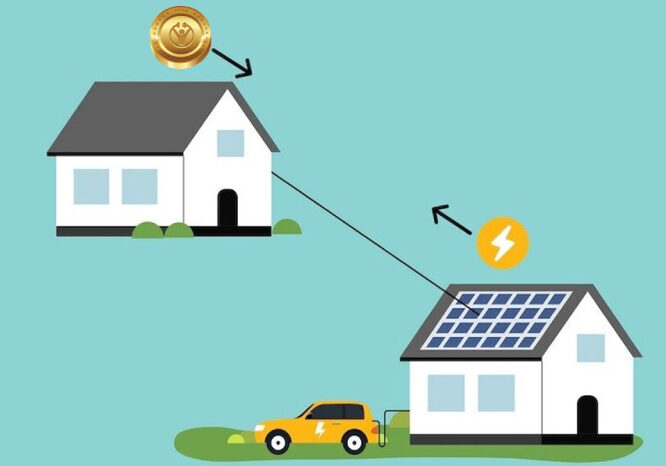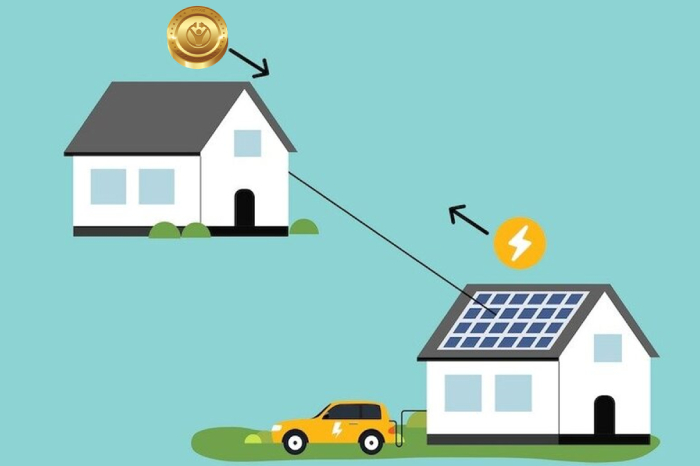What's On > News
Peer to Peer Energy Trading
If I have too much power could I sell it my neighbour?
This idea is called P2P Energy Trading. Turns out its quite complicated in reality.
What is Peer to Peer Energy Trading?
There are a number of possible approaches to energy sharing. For example:
- Peer-to-peer: A single entity – for example, a business equipped with a solar array – shares its surplus directly with another entity.
- One to many: A single entity distributes surplus to several others – as in the case of the example above, or a business that chooses to benefit its employees.
- Many to one: Here, several entities contribute their surplus to an aggregated ‘fund’ that then manages and distributes the value of the energy, which can be used to enable further projects to occur.
Surplus may be shared directly – across, for instance, a community or micro grid. Alternatively, and more commonly, communities can set up a virtual centralised system that enables each participant to manage their own energy usage.
In any scenario, the surplus may be shared as ‘electricity’ (by netting the value of the energy off another’s bill), or as funds (e.g., revenue from power sold back to the grid on a feed-in tariff).
The benefits of energy sharing
Making the most efficient use of clean energy resources will help Aotearoa decarbonise the national grid and achieve its net zero commitments, while also benefiting the environment. It also helps at times of energy scarcity, by adding additional coordinated sources of distributed generation that can bolster the grid when required.
Community energy-sharing schemes foster local connections. People equipped with energy resources (such as a solar array) effectively become ‘prosumers’: active participants in the energy system/market. Local storage of shared energy using a battery enables participants to cut their power bills and emissions – for instance, by drawing on stored reserves of clean power during peak demand in the mornings and evenings, when solar production is low and grid power is more costly.
More specifically, sharing can alleviate energy hardship. Our poorest households are spending roughly 25 per cent of their income (up from around 12 per cent in 2010) on heating and power. Official data reports around 100,000 homes are disconnected every quarter due to non-payment of bills, but unofficial data estimates the more realistic figure is three times that, due to the number of people on pre-pay power who self-disconnect for periods of days to weeks to save money. These people are also typically spending more per month on power than a household in good-quality housing, because of the high cost of heating drafty, poorly insulated homes.
Energy sharing can also create resilience by ensuring a more stable delivery of energy; with less reliance on the national grid, a community is better equipped to ride out climate-related events such as storms or flooding. In turn, local energy sharing reduces stress on the national grid.
Can it work in Auckland?
Here’s what Genesis Energy has to say
“It’s important to know that P2P platforms are only a way of interacting with the energy market, they’re not actually bypassing the grid or transferring specific power from one home to another. Unless you go off the grid entirely, your energy supply comes through the same system of lines and distributors as everyone else’s.
Around 35% of your energy bill is made up of the costs of lines maintenance, distribution and metering – and those costs must still be paid if you use an alternative platform to trade energy. Those costs will still apply when you use a P2P platform, but it could provide more options for users by cutting some of the retail costs”
Ara Ake Trial
Ara Ake is leading a pilot program focused on Multiple Trading Relationships (MTR), which is a type of peer-to-peer (P2P) energy trading. This programme aims to explore how MTRs can benefit New Zealanders by introducing more competition in the electricity market, potentially lowering costs, reducing energy hardship, and encouraging the uptake of renewable energy technologies like solar.
Ara Ake are partnering with Kainga Ora.
The energy sharing pilot, has Kāinga Ora homes fitted with solar panels will be able to share the benefit of excess solar with customers whose roofs are unsuitable for solar installations.
Ara Ake is piloting the concept of MTR, which aims to introduce more competition into the electricity sector, making electricity cheaper for customers, helping reduce energy hardship and allowing for a greater uptake of low emission technologies, such as solar


